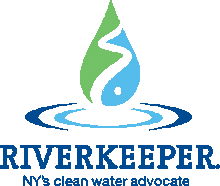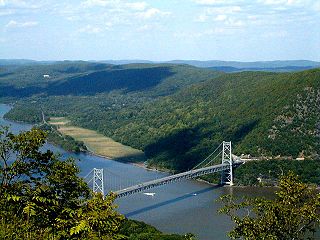
The Hudson River is a 315-mile (507 km) river that flows from north to south primarily through eastern New York, United States. It originates in the Adirondack Mountains of upstate New York at Henderson Lake in the town of Newcomb, and flows southward through the Hudson Valley to the New York Harbor between New York City and Jersey City, eventually draining into the Atlantic Ocean at Upper New York Bay. The river serves as a physical boundary between the states of New Jersey and New York at its southern end. Farther north, it marks local boundaries between several New York counties. The lower half of the river is a tidal estuary, deeper than the body of water into which it flows, occupying the Hudson Fjord, an inlet that formed during the most recent period of North American glaciation, estimated at 26,000 to 13,300 years ago. Even as far north as the city of Troy, the flow of the river changes direction with the tides.

The Natural Resources Defense Council (NRDC) is a United States–based 501(c)(3) non-profit international environmental advocacy group, with its headquarters in New York City and offices in Washington, D.C., San Francisco, Los Angeles, Chicago, Bozeman, India, and Beijing. The group was founded in 1970 in opposition to a hydroelectric power plant in New York.

The Cuyahoga River is a river located in Northeast Ohio that bisects the City of Cleveland and feeds into Lake Erie.
Waterkeeper Alliance is a worldwide network of environmental organizations founded in 1999 that work to protect bodies of water around the United States and the world. By December 2019, the group said it had grown to 350 members in 46 countries, with half the membership outside the U.S.; the alliance had added 200 groups in the last five years.
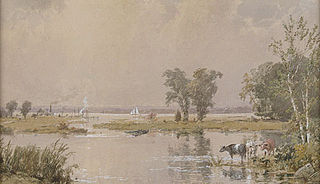
New Jersey Meadowlands, also known as the Hackensack Meadowlands after the primary river flowing through it, is a general name for a large ecosystem of wetlands in northeastern New Jersey in the United States, a few miles to the west of New York City. During the 20th century, much of the Meadowlands area was urbanized, and it became known for being the site of large landfills and decades of environmental abuse. A variety of projects began in the late 20th century to restore and conserve the remaining ecological resources in the Meadowlands.

Hydroelectricity, or hydroelectric power, is electricity generated from hydropower. Hydropower supplies 15% of the world's electricity, almost 4,210 TWh in 2023, which is more than all other renewable sources combined and also more than nuclear power. Hydropower can provide large amounts of low-carbon electricity on demand, making it a key element for creating secure and clean electricity supply systems. A hydroelectric power station that has a dam and reservoir is a flexible source, since the amount of electricity produced can be increased or decreased in seconds or minutes in response to varying electricity demand. Once a hydroelectric complex is constructed, it produces no direct waste, and almost always emits considerably less greenhouse gas than fossil fuel-powered energy plants. However, when constructed in lowland rainforest areas, where part of the forest is inundated, substantial amounts of greenhouse gases may be emitted.
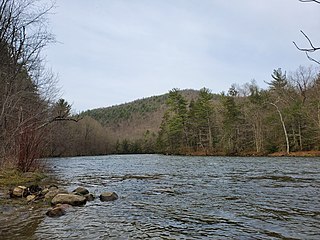
The Housatonic River is a river, approximately 149 miles (240 km) long, in western Massachusetts and western Connecticut in the United States. It flows south to southeast, and drains about 1,950 square miles (5,100 km2) of southwestern Connecticut into Long Island Sound.

Robert Francis Kennedy Jr., also known by his initials RFK Jr., is an American politician, environmental lawyer, anti-vaccine activist, and conspiracy theorist who will be nominated to serve as United States Secretary of Health and Human Services. He is the chairman and founder of Children's Health Defense, an anti-vaccine advocacy group and proponent of COVID-19 vaccine misinformation. He was on the ballot in some states as an independent candidate in the 2024 United States presidential election. A member of the Kennedy family, he is a son of U.S. attorney general and senator Robert F. Kennedy, and a nephew of U.S. president John F. Kennedy and senator Ted Kennedy.

The Hackensack River is a river, approximately 45 miles (72 km) long, in the U.S. states of New York and New Jersey, emptying into Newark Bay, a back chamber of New York Harbor. The watershed of the river includes part of the suburban area outside New York City just west of the lower Hudson River, which it roughly parallels, separated from it by the New Jersey Palisades. It also flows through and drains the New Jersey Meadowlands. The lower river, which is navigable as far as the city of Hackensack, is heavily industrialized and forms a commercial extension of Newark Bay.

The Coosa River is a tributary of the Alabama River in the U.S. states of Alabama and Georgia. The river is about 280 miles (450 km) long.

Indian Point Energy Center (I.P.E.C.) is a now defunct three-unit nuclear power station located in Buchanan, just south of Peekskill, in Westchester County, New York. It sits on the east bank of the Hudson River, about 36 miles (58 km) north of Midtown Manhattan. The facility permanently ceased power operations on April 30, 2021. Before its closure, the station's two operating reactors generated about 2,000 megawatts (MWe) of electrical power, about 25% of New York City's usage. The station is owned by Holtec International, and consists of three permanently deactivated reactors, Indian Point Units 1, 2, and 3. Units 2 and 3 were Westinghouse pressurized water reactors. Entergy purchased Unit 3 from the New York Power Authority in 2000 and Units 1 and 2 from Consolidated Edison in 2001.
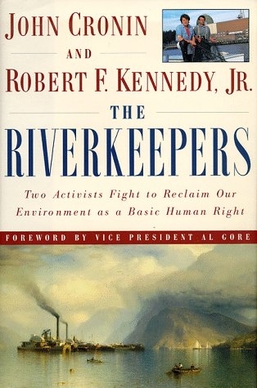
The Riverkeepers: Two Activists Fight to Reclaim Our Environment as a Basic Human Right is a 1997 book written by John Cronin and Robert F. Kennedy, Jr.

A fish screen is designed to prevent fish from swimming or being drawn into an aqueduct, cooling water intake, intake tower, dam or other diversion on a river, lake or waterway where water is taken for human use. They are intended to supply debris-free water without harming aquatic life. Fish screens are typically installed to protect endangered species of fishes that would otherwise be harmed or killed when passing through industrial facilities such as steam electric power plants, hydroelectric generators, petroleum refineries, chemical plants, farm irrigation water and municipal drinking water treatment plants. However, many fish are killed or injured on screens or elsewhere in the intake structures.

Moodna Creek is a small tributary of the Hudson River that drains eastern Orange County, New York. At 15.5 miles (25 km) in length from its source at the confluence of Cromline Creek and Otter Kill west of Washingtonville, it is the longest stream located entirely within the county.

Quassaick Creek is an 18.4-mile-long (29.6 km) tributary of the Hudson River in Orange and Ulster counties in the U.S. state of New York. It rises in the glacial ridges west of the river, near the boundary between the towns of Plattekill and Marlborough. From there it flows south into the town of Newburgh and then the city, where it eventually forms part of the border between it and neighboring New Windsor before emptying into the Hudson.

Potomac Riverkeeper Network is an environmental, registered non-profit organization based in Washington, D.C. that is dedicated to protecting the Potomac River and its tributaries. As a "riverkeeper" organization, it is a member of the umbrella organization Waterkeeper Alliance.

The Pocantico River is a nine-mile-long (14 km) tributary of the Hudson River in western central Westchester County, New York, United States. It rises from Echo Lake, in the town of New Castle south of the hamlet of Millwood, and flows generally southwest past Briarcliff Manor to its outlet at Sleepy Hollow. Portions of the towns of Mount Pleasant and Ossining are within its 16-square-mile (41 km2) watershed.

Between 1947 and 1977, General Electric polluted the Hudson River by discharging polychlorinated biphenyls (PCBs) causing a range of harmful effects to wildlife and people who eat fish from the river. Other kinds of pollution, including mercury contamination and cities discharging untreated sewage, have also caused problems in the river.
The Klamath River Hydroelectric Project was a series of hydroelectric dams and other facilities on the mainstem of the Klamath River, in a watershed on both sides of the California-Oregon border.

Robert Hamilton Boyle Jr. was an environmental activist, conservationist, book author, journalist and former senior writer for Sports Illustrated. In 1966, Boyle founded the Hudson River Fishermen's Association (HRFA) with its members serving as sentries to protect the river and its inhabitants, help reverse the deterioration caused by river pollution, and bring polluters to justice. The organization grew over the years, and in 1986, was officially renamed Riverkeeper after being merged with HRFA's Riverkeeper program. It was the first "keeper" group in the global Waterkeeper Alliance movement.
